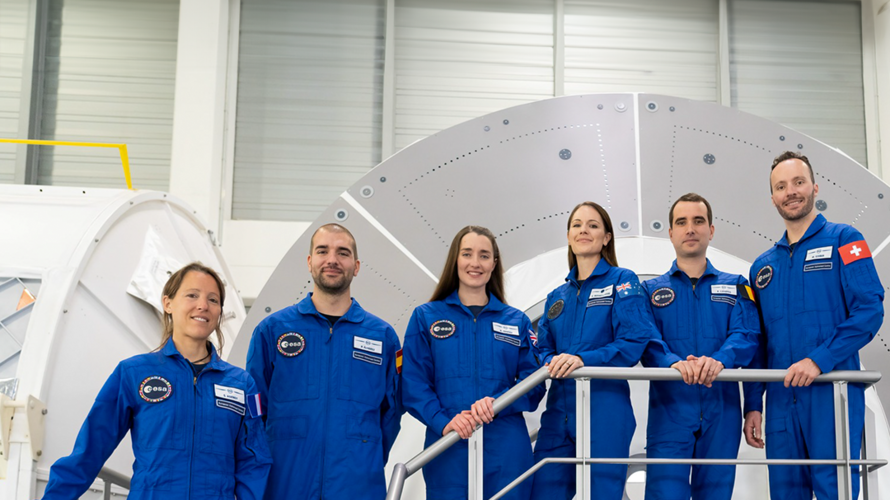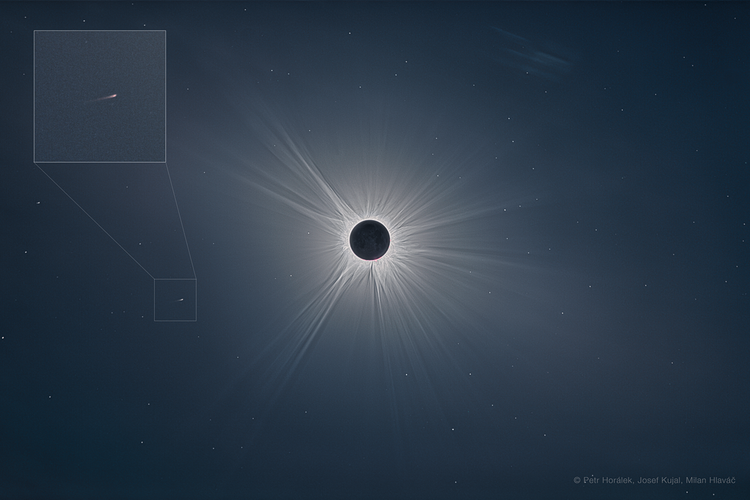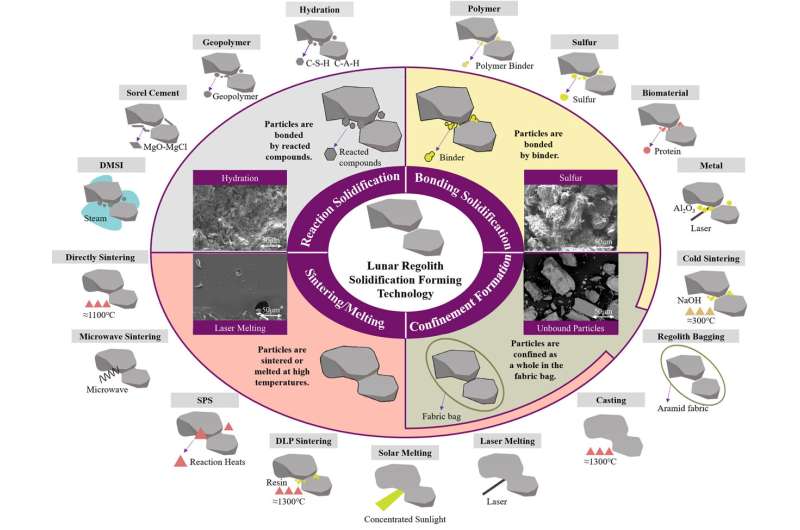Watch live: ESA astronaut class of 2022 graduation ceremony
Friday, 19 April 2024 06:51
Rare sighting of ‘doomed’ SOHO comet during solar eclipse
Friday, 19 April 2024 06:30 Image:
Photo of total solar eclipse
Image:
Photo of total solar eclipse Researchers quantify the ideal in situ construction method for lunar habitats
Thursday, 18 April 2024 18:28
As the lunar exploration mission evolves from exploration to construction and utilization, in situ lunar construction becomes an imperative requirement. The key is regolith solidification and formation, aiming to maximize local resource utilization while minimizing transportation and maintenance costs.
Nearly 20 techniques have been employed for preparing regolith-based construction materials, each with distinct requirements and capabilities. Professor Feng from Tsinghua University has conducted a comprehensive review, precise classification, and quantitative evaluation of regolith solidification and formation techniques, shedding light on key challenges and future development directions.
Census of cosmic neighbors reveals new insights with help from citizen scientists
Thursday, 18 April 2024 17:44 Using various telescopes, scientists, including volunteer citizen scientists worldwide, have mapped over 3,500 cosmic entities within 65 light-years of the Sun through the Backyard Worlds: Planet 9 project.
A recent study published in The Astrophysical Journal details these findings, highlighting that stars outnumber brown dwarfs by four to one in this sector, yet low-mass objects prevail
Using various telescopes, scientists, including volunteer citizen scientists worldwide, have mapped over 3,500 cosmic entities within 65 light-years of the Sun through the Backyard Worlds: Planet 9 project.
A recent study published in The Astrophysical Journal details these findings, highlighting that stars outnumber brown dwarfs by four to one in this sector, yet low-mass objects prevail Max Space unveils new expandable space habitats
Thursday, 18 April 2024 17:44 During the 39th Space Symposium, Max Space, a pioneering space company, showcased its innovative expandable habitat technology. This technology is distinguished by its ability to scale indefinitely while ensuring structural stability, positioning Max Space as a unique player in the space habitation sector. This capability is anticipated to facilitate mass production and significantly lower the c
During the 39th Space Symposium, Max Space, a pioneering space company, showcased its innovative expandable habitat technology. This technology is distinguished by its ability to scale indefinitely while ensuring structural stability, positioning Max Space as a unique player in the space habitation sector. This capability is anticipated to facilitate mass production and significantly lower the c Lunar i-hab mockup completes acceptance review at Thales Alenia Space
Thursday, 18 April 2024 17:44 The European Space Agency's Lunar I-Hab initiative has achieved a significant milestone at the Thales Alenia Space facility in Turin with the completion of the Acceptance Review of the mockup, delivered by Liquifer Space Systems. This event underscores the advancement toward a sustained human presence in lunar orbit.
The mockup, a full-scale version of the intended flight module, includes
The European Space Agency's Lunar I-Hab initiative has achieved a significant milestone at the Thales Alenia Space facility in Turin with the completion of the Acceptance Review of the mockup, delivered by Liquifer Space Systems. This event underscores the advancement toward a sustained human presence in lunar orbit.
The mockup, a full-scale version of the intended flight module, includes NASA gears up for another Mars simulation mission
Thursday, 18 April 2024 17:44 In an effort to further humanity's journey to Mars, NASA has carefully selected a diverse group of four volunteers to undergo an intensive 45-day simulated mission to the Red Planet. This simulation will take place at the Johnson Space Center's Human Exploration Research Analog (HERA), a facility meticulously designed to mimic the conditions of space travel and planetary exploration.
Parti
In an effort to further humanity's journey to Mars, NASA has carefully selected a diverse group of four volunteers to undergo an intensive 45-day simulated mission to the Red Planet. This simulation will take place at the Johnson Space Center's Human Exploration Research Analog (HERA), a facility meticulously designed to mimic the conditions of space travel and planetary exploration.
Parti NASA Observations Find What Helps Heat Roots of 'Moss' on Sun
Thursday, 18 April 2024 17:44 Did you know the Sun has moss? Due to its resemblance to the earthly plants, scientists have named a small-scale, bright, patchy structure made of plasma in the solar atmosphere "moss." This moss, which was first identified in 1999 by NASA's TRACE mission, blossoms around the center of a sunspot group, where magnetic conditions are strong. It straddles two atmospheric layers known as the chromos
Did you know the Sun has moss? Due to its resemblance to the earthly plants, scientists have named a small-scale, bright, patchy structure made of plasma in the solar atmosphere "moss." This moss, which was first identified in 1999 by NASA's TRACE mission, blossoms around the center of a sunspot group, where magnetic conditions are strong. It straddles two atmospheric layers known as the chromos EarthCARE satellite prepares for upcoming launch
Thursday, 18 April 2024 17:44 ESA's EarthCARE satellite has recently been unpacked at its launch site in Vandenberg, California, after a lengthy journey from Germany and a month-long storage period. The satellite is now undergoing preparations for its anticipated launch in May.
The Earth Cloud Aerosol and Radiation Explorer (EarthCARE) is equipped with four advanced instruments designed to analyze the interactions betw
ESA's EarthCARE satellite has recently been unpacked at its launch site in Vandenberg, California, after a lengthy journey from Germany and a month-long storage period. The satellite is now undergoing preparations for its anticipated launch in May.
The Earth Cloud Aerosol and Radiation Explorer (EarthCARE) is equipped with four advanced instruments designed to analyze the interactions betw Tyvak International's Centauri-6 satellite enters operational orbit
Thursday, 18 April 2024 17:44 Tyvak International SRL, a subsidiary of Terran Orbital Corporation (NYSE: LLAP) based in Torino, Italy, has announced the successful launch of the Centauri-6 satellite. Developed in collaboration with Fleet Space Technologies, the satellite was deployed during the SpaceX Bandwagon-1 mission from Launch Complex 39A at Kennedy Space Center in Florida at 23:16 UTC on April 7th.
"We are thril
Tyvak International SRL, a subsidiary of Terran Orbital Corporation (NYSE: LLAP) based in Torino, Italy, has announced the successful launch of the Centauri-6 satellite. Developed in collaboration with Fleet Space Technologies, the satellite was deployed during the SpaceX Bandwagon-1 mission from Launch Complex 39A at Kennedy Space Center in Florida at 23:16 UTC on April 7th.
"We are thril Orbital changes suggest recent formation of underground ocean on Saturn's Mimas
Thursday, 18 April 2024 17:44 Recent studies suggest that Mimas, one of Saturn's moons, has developed a substantial underground ocean due to a decrease in its orbital eccentricity, leading to the melting and thinning of its icy exterior.
"Previously, we established that Mimas could currently host an ocean world only if it previously had a thicker icy shell. However, the process transitioning from thick to thinner ice w
Recent studies suggest that Mimas, one of Saturn's moons, has developed a substantial underground ocean due to a decrease in its orbital eccentricity, leading to the melting and thinning of its icy exterior.
"Previously, we established that Mimas could currently host an ocean world only if it previously had a thicker icy shell. However, the process transitioning from thick to thinner ice w The paradox of U.S. government R&D funding: Barriers for non-U.S. owned firms
Thursday, 18 April 2024 16:00








